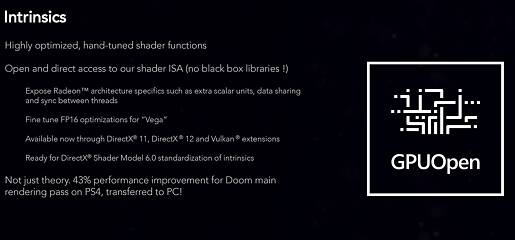 29
29
AMD Vega Microarchitecture Technical Overview
Display Engine, Virtualization & Security Engines »New Graphics Features
AMD has traditionally been at the forefront of introducing new APIs and supporting others, with Mantle being a key focus during the launch of their "Hawaii" microarchitecture. While Mantle as it was is practically dead now, most of it lives on in DX12 and Vulkan APIs, and AMD designed Vega to provide the best feature support yet for these modern APIs, of any other consumer GPU architecture. With DX12, the higher the tier level of support, the better it is, and a quick look at the table above shows how Vega exceeds both AMD Polaris and NVIDIA Pascal here. NVIDIA has promised a higher level of support with upcoming microarchitectures of their own, but for now, AMD is lord of the DX12 manor again.
Continuing the extended support path, AMD has finally added support for conservative rasterization with Vega - a Direct3D 11 feature NVIDIA has had since Maxwell. Conservative rasterization means that all pixels that are at least partially covered by a rendered primitive are rasterized, which means that the pixel shader is invoked. Normal behavior is sampling, which is not used if conservative rasterization is enabled. This is especially handy in situations involving collision detection, shadows, occlusion culling, and visibility detection.
With Direct3D 12, an additional control of overestimated or underestimated conservative rasterization has been added, which is also supported (as Tier 1 level) by Vega. In underestimated mode, only the pixels that are fully covered by a rendered primitive are rasterized. Underestimated conservative rasterization information is available through the pixel shader via the use of input coverage data, whereas only overestimated conservative rasterization is available as a regular rasterizing mode.
With Vega, AMD has also devised a new method to deal with the geometry pipeline. This also comes down to effective pixel shading and rasterization, wherein the new "Primitive Shader" combines both geometry and vertex shader functionality to increase peak throughput by as much as a 100% in the native pipeline relative to Fiji. The base improvement immediately helps in the rendering of scenes with millions of polygons where only a fraction is visible on screen at all times - a video game environment is a prime example here, with objects in front of others. Implementing primitive shader support comes partly with DX12 and Vulkan, but ultimately falls to the developers again, which can end up limiting the applications that make use of it. To aid in its adoption, AMD has increased the discard rate for the native pipeline by ~2x that of Fiji but, more importantly, by as much as 5x via the Vega NGG fast path implementation. Again, there has been no mention of NGG fast path being available any time soon, so it is a feature that may end up being theoretical only.
Ah, asynchronous compute - the one DX12 feature that caught NVIDIA unaware to where Ashes of the Singularity is still used by AMD to demonstrate their prowess here. With Vega, async compute continues to allow for both graphical and compute workloads to be processed simultaneously. Nothing new has been added specifically to Vega over GCN as a whole, with AMD claiming their architecture continues to handle it better than the competition.
GPU Open continues to be supported by AMD, and we touched on this when we covered AMD's Radeon Crimson ReLive Edition 17.7.2. Open source shader functions developed by AMD as part of the initiative with collaboration from industry partners, including DICE and id Software, have helped optimize GCN-based shader units for FP16 operations. This again is not necessarily Vega exclusive as the data used to quantify the optimization comes from a Doom (2016) developer presentation at SIGGRAPH 2016 for AMD's GCN architecture as a whole.
Jun 30th, 2025 16:45 CDT
change timezone
Latest GPU Drivers
New Forum Posts
- HTPC Power Consumption Discussion, Upgrade vs Migration (18)
- RX 9000 series GPU Owners Club (1103)
- Will you buy a RTX 5090? (579)
- Rare GPUs / Unreleased GPUs (2111)
- Steam Deck Owners Clubhouse (530)
- Can you guess Which game it is? (193)
- Good time in the year to buy a new PC (4)
- Help me choose the right PSU , Cooler Master vs Seasonic (52)
- The TPU UK Clubhouse (26528)
- Vega owners club (586)
Popular Reviews
- Sapphire Radeon RX 9070 XT Nitro+ Review - Beating NVIDIA
- Sapphire Radeon RX 9060 XT Pulse OC 16 GB Review - Samsung Memory Tested
- ASUS ROG Crosshair X870E Extreme Review
- Lexar NQ780 4 TB Review
- AVerMedia CamStream 4K Review
- ASRock Phantom Gaming Z890 Riptide Wi-Fi Review
- AMD Ryzen 7 9800X3D Review - The Best Gaming Processor
- Upcoming Hardware Launches 2025 (Updated May 2025)
- Intel Core Ultra 7 265K Review
- NVIDIA GeForce RTX 5060 8 GB Review
TPU on YouTube
Controversial News Posts
- Intel's Core Ultra 7 265K and 265KF CPUs Dip Below $250 (288)
- NVIDIA Grabs Market Share, AMD Loses Ground, and Intel Disappears in Latest dGPU Update (204)
- Some Intel Nova Lake CPUs Rumored to Challenge AMD's 3D V-Cache in Desktop Gaming (140)
- Microsoft Partners with AMD for Next-gen Xbox Hardware (105)
- NVIDIA Launches GeForce RTX 5050 for Desktops and Laptops, Starts at $249 (104)
- Intel "Nova Lake‑S" Series: Seven SKUs, Up to 52 Cores and 150 W TDP (100)
- NVIDIA GeForce RTX 5080 SUPER Could Feature 24 GB Memory, Increased Power Limits (88)
- Reviewers Bemused by Restrictive Sampling of RX 9060 XT 8 GB Cards (88)








